
Arch
443/646: Architecture and Film
Fall 2011
300 (2005)
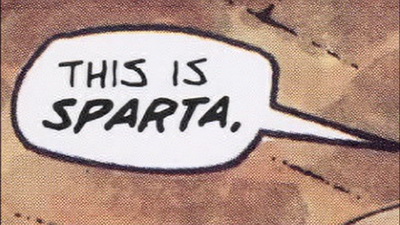
 |
Arch
443/646: Architecture and Film 300 (2005) |
 |
Discussion Questions:
Remember, your images are ABOVE your name.
Please answer the questions below. Use paragraph form. Email me your responses in Word .doc format to: tboake@sympatico.ca I will be posting these each week after the class. You should be prepared to deliver your answer in class -- but paraphrase, do not read it. THINGS TO KEEP IN MIND WHEN ANSWERING THESE QUESTIONS: I am looking for general observations about the film and the relationship to any aspect of f/x that we have examined. The images attached to your "words" are to clarify the intention but are not meant to be action specific. We are tying the films 300 and Sin City together....plus any other films that you might find of value in your discussion. |
x |
|||||
| 1. | 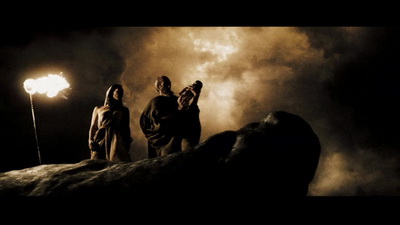 |
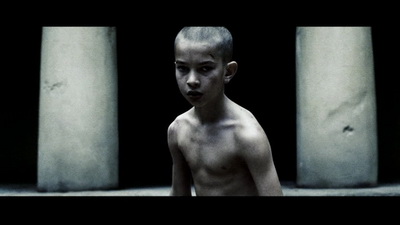 |
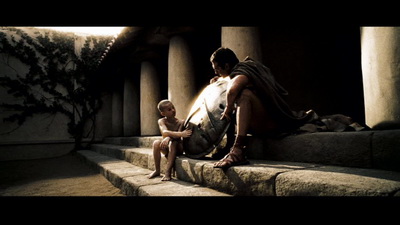 |
||
Jennifer Beggs The opening moments of the film set up the feel and approach for the movie. It is important to submerge the viewers into the right frame of mind in order to ensure the significant and critical elements are emphasized properly to allow the movie to unveil itself properly, as the director had intended it. When introducing different elements, characters and situation to a movie, it is important people get the same impression that the director had planned so that the movie reveals itself to match the narrative. Typically in films the colour red represents passion, destiny and obsession. Blue is typically used to portray a gloomy, suspenseful and uncertain feel. At the beginning of the film 300, the opening scene begins dark with short, intense flashes of white lights. It creates an uneasy and unstable feeling with the sharp changes in lighting and atmosphere. It suggests that something is unknown and uncertain. The first appearance of the colour red comes in lighting, when the baby is introduced to the movie. Being the first person who appears in the movie, the use of red lighting gives a strong introduction that the baby and the baby’s life’s journey is going to be of great significance. The baby is glowing red and has red lights casting on him when he is being held up to the camera. This red light is significant to the baby’s destiny and emphasizes that the baby is very important. The scene then cuts to the baby who has now grown up into a little boy and is in a fight with a grown man. The colour tone is predominantly blue and the saturation level is very low. This creates a very suspenseful mood to go along with the fight. It is perhaps foreshadowing great things to come but with struggles; the baby was glowing red, foreshadowing a great destiny and here he is fighting. This suggests a future of conquering a battle or leading an army to success. Shortly after the fight scene, a wolf-like animal appears with eyes glowing red. The colour chosen for his eyes was intentionally chosen to instil a notion of importance and powerful impact on the characters. The red glow is a sign of a fierce fire inside of the animal – it is ready to fight and is a metaphor of the little boy whose journey in life is all about fighting for his people. |
|||||
| 2. |
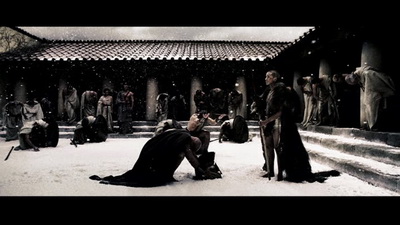 |
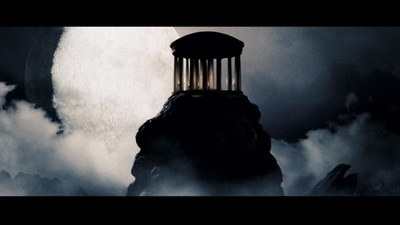 |
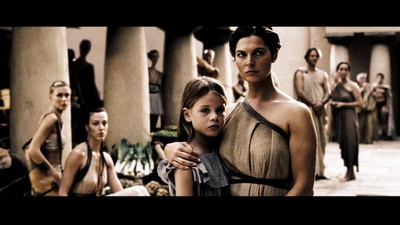 |
||
Jaliya Fonseka Since the landscape and environment seemed very distant and somewhat artificial and disconnected in the film 300, even the minor depiction of an architectural setting was crucial in grounding the film. This architectural setting aided in convincing the viewer of the film and their overall understanding of the film, which in turn enhanced its realism.
|
|||||
| 3. | 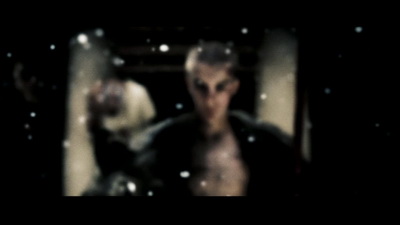 |
 |
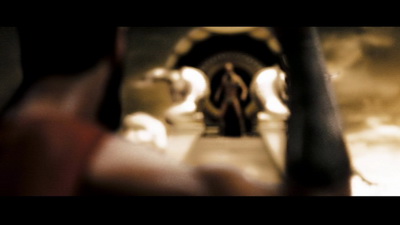 |
||
Miles Gertler In Zack Snyder's 300, the manipulation of focal blur is used ubiquitously throughout to achieve a variety of ends. Throughout Snyder's film there is an evident desire to represent the narrative in stylistic means similar to those found in the original graphic novel. One example is his use of slow motion, allowing the viewer to experience the near-still image as if it were a pose in a comic frame. Often in Frank Miller's original work, only the main or foreground elements of a scene are illustrated or rendered in detail. Focal blur can be seen as this drawing technique's cinematic equivalent. Perhaps also it is used to stay stylistically true to the novel as Snyder attempts with other qualities of the film version. Where deep focus, a shot that focuses clearly on all elements in widely separated planes, is often used to represent reality in a way that viewers perceive as true (photorealistic, as we would see it), a shallow focus and manipulation of depth of field portrays even normal scenes in a dramatized manner, much as Snyder does with his use of slow motion. Snyder often employs a dynamic focal blur in his film. That is, in which the focus changes between planes in the space of the shot. The effect is that the viewer follows the shifting focus like a visual divining rod, led by it toward the point of intent. Not only does this indicate psychological introspection, as only the character in focus is singled out from the blurry world around them, but it also extends the entertainment value of a single shot, appealing to a short attention span by ensuring that the narrative continues to move with the dynamic pace of the focus. For instance, we see the focus shift from a young Leonidas to the wolf in the extended opening montage. Had Snyder used deep focus here, the dramatic quality of the scene would be minimized, and since all elements would be evident in a single glance, the length of the shot, which relates delicately to the building sense of tension, would likely have been shortened and potentially out of sync with the tone of the narrative. Furthermore, the shift from Leonidas' head to the body of the wolf indicates the unshakable focus of the future King. Ultimately, Snyder's use of focal blur generates an effect that directly affects the telling of the story through its impact on style, perception of character, and of narrative.
|
|||||
| x | 4. | 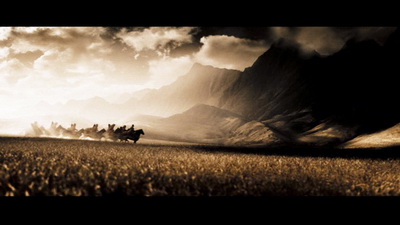 |
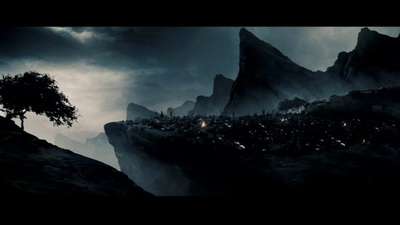 |
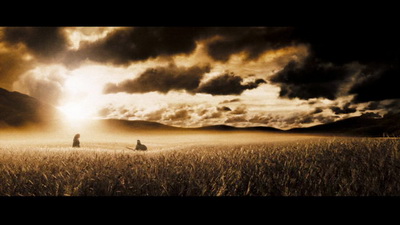 |
x |
Suzan Ibrahim Shots of distant landscapes can provide a wide scope of the atmosphere and context in which all the characters within the movie inhabit. The distant shot and blending of the horizon in 300 takes place in different parts of the movie for to achieve a strong grounding in the story and to represent the struggle between the relationships, cultures in war and the responsibility a king has to his country. One of the first shots of the movie introduced a landscape that informed the viewer that such a vast space had a distance that took time to travel across and must be in a far away secluded place, out of reach to many people. 300 takes time in a period where the major transportation was by horses, and where such travels would be a great challenge and strain on families during war and conflict. Several times there was a shot of the King looking over the horizon across the land; the length of his gaze in combination with the view gave the sense of a weight of his responsibility towards his land and a certain respect that he held to it. His gaze into the landscape where the earth almost fades with the sky gave the impression that he was as well thinking of the future; of how it would be if he would be able to return to his son and wife after the war. The landscape is both a way of giving the viewer a context, but also a possibility to sympathize with the character that seems to be in such a distant space and field secluded from much escape into what seems open and free. The landscape shots where also found as checkpoints within displacements in the movie. As scenes and characters where switched, a landscpae of the new context was always carefully introduced to give an idea of the atmosphere and the characters inhabiting it (whether that atmosphere was where they belonged or not). Other times the landscapes acted as a comparison of how it is serene by itself but also was a dangerous field in which wars and conflicts took place. It acted as a space-holder for where all the characters would end up meeting up. Most of the scenes had been adjusted to look almost like an impressionist painting, like a Turner painting where it has more of a story-like quality than a reality.
|
|||||
| 5. | 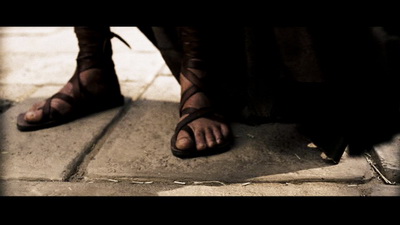 |
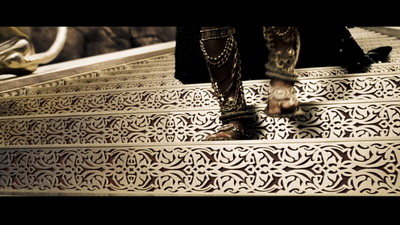 |
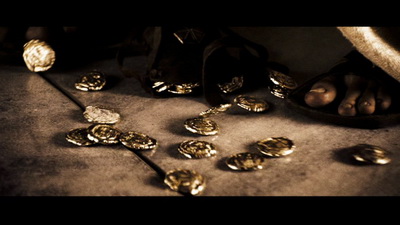 |
||
David McMurchy
|
|||||
| 6. | 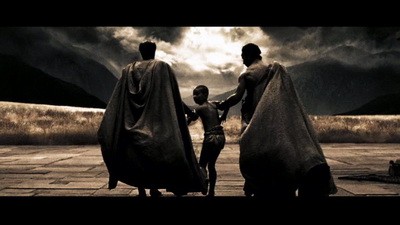 |
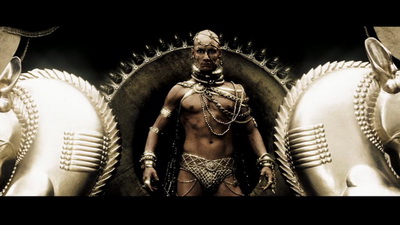 |
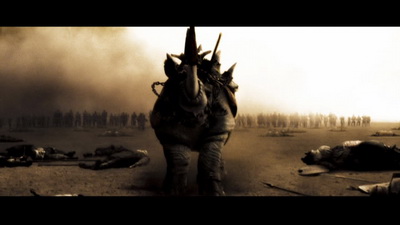 |
||
Benny Or
|
|||||
7. |
 |
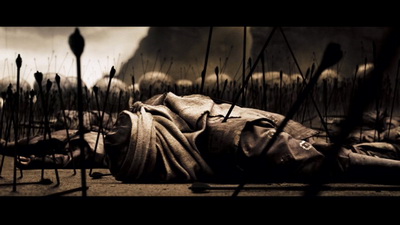 |
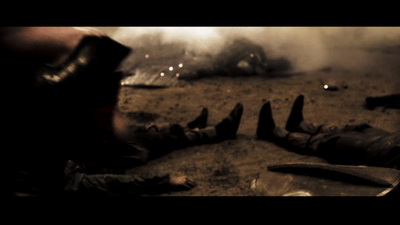 |
||
William Pentesco Camera angle in film can change how the audience perceives the subject. If shot high the subject may seem small and diminutive, if shot low then the subject may seem tall and impressive. A low angle shot is one where the camera is located below eye level (5 or 6 feet) and aimed up. Extreme low angle shots are a variant of that, taking the low part to the max. Extreme low angle shots are used in moments where characters of importance are introduced into the storyline, or moments of pause in an action packed sequence.
|
|||||
| 8. | 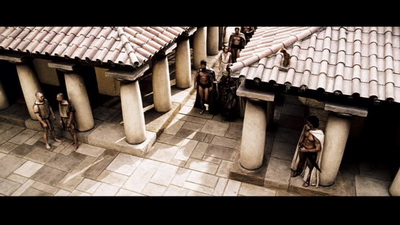 |
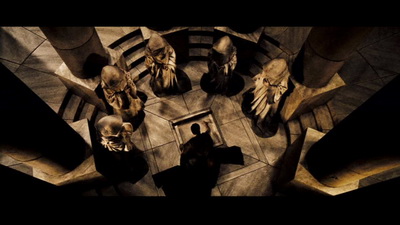 |
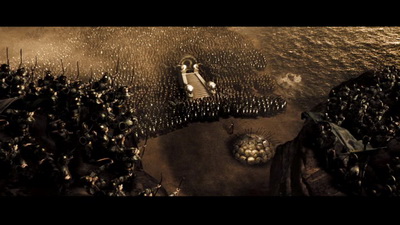 |
||
Emmanuelle Sainté The movie 300 uses a number of high angle shots, which help to establish a mood and evoke emotions in the audience. They are also used to propel the story quickly, without resorting to dialogue.
|
|||||
| 9. | 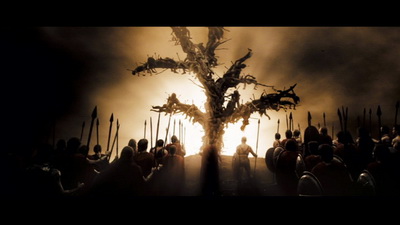 |
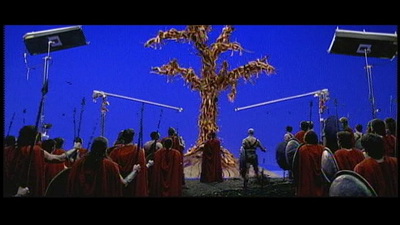 |
|||
Tristan van Leur The special effects in 300 are what allow the movie to be successful. The blue screen is the key component in making this happen. 300 is a simple, yet absurd Greek legend. Frank Miller stylized this myth and turned it into a beautiful and interesting work of art. He paraded the absurdity of the tale, and highlighted the obvious folklore. The key to the movie was the success in stylizing the tale, and keeping the mood and art that was displayed in the graphic novels. The blue screen is the key component to making this happen. The entire story hinges on these mythical cliffs that wall off the Spartan capital from the sea and create a narrow channel for the Spartan warriors. In the world, it is unlikely to find such a fantastic place, but the blue screen allows them to translate the renderings from the graphic novel into a realistic scene, allowing a place for the tale to unfold. Beyond simple scenery, beasts, and special effects play a massive role in furthering the tale. It shows the strength and power of the Spartans, turning them into something beyond human, captivating the audience with their strength and fearlessness. But what makes 300 a successful film is the way the highlight the fantasy of this world; the sky colours, the cliffs, and the beasts. It is this literal translation from the images of the book that creates the fantastic style in which the film is shot. The blue screen is the vehicle that drives this stylistic masterpiece, and is the only thing that makes this film possible. The real question is, where would this film be without blue screen technologies, and my suspicion is it would be entirely unwatchable. The thing that makes the movie enjoyable is the manner in which it basks in its absurdities and clichés, none of those would be possible without the blue screen.
|
|||||
| 10. | 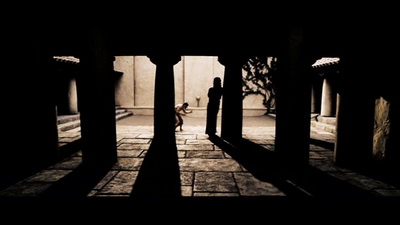 |
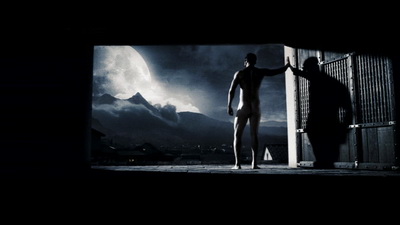 |
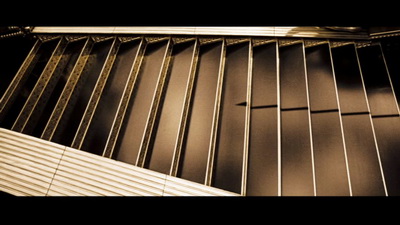 |
||
Benjamin Van Nostrand In these particular scenes, shadow is used as a natural framing element within the boundaries of the shot's crop, as a balancing element in articulating interesting compositions, and as a sort of conceptual refinery that abstracts and distills objects, displaying their essence with minimal distraction. Within the frame, shadows provide an advantageous opportunity to subdivide the shot and, in creating several sub-frames within the main frame, either focus the viewer's attention or scatter it. Most importantly though, the stylized use of shadows serves to boil down the essence of things. The shadow of a spear is a pure spear, uncluttered with the visual distractions that make the CG soundstage details so compelling. Similarly, the shadow of the wolf against the cliff wall is just as intimidating as the head-on shots of the wolf, but without the visual glamour of mangy fur and glistening saliva to distract from the essence of what is going on in the scene. Additionally, shadows emphasize or even exaggerate formal character traits that can reinforce the viewer's opinion of a character – the wolf's size and general creepiness is obvious when seen in silhouette, Leonidas' manly shadow makes him appear even beefier and stronger, and Ephialtes' deformed appearance is further emphasized by his irregular shadow. On a technical level, the use of shadows is also advantageous in turning bluescreen soundstages into realistic environments. It is helpful to cheat the points of interface between the actors and the blue surfaces they touch by overlaying an artificial shadow. The shadow also makes scenes feel more realistic by directly connecting the real-world component (human actor) to the digital component (computer-generated world) by projecting their silhouette onto the planes of the digital set. Shadow also creates a sense of spatial depth or layering within the sometimes planar world of CG sets, helping fill out the digital models and visually extending their forms into three dimensions.
|
|||||
| 11. | 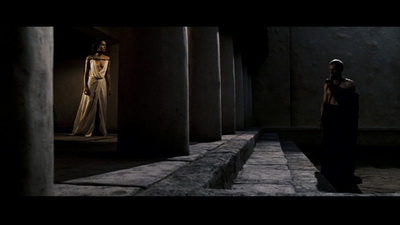 |
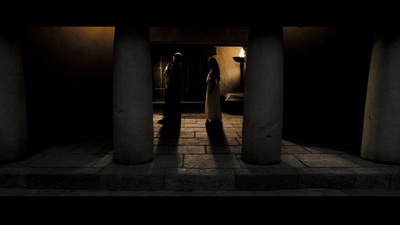 |
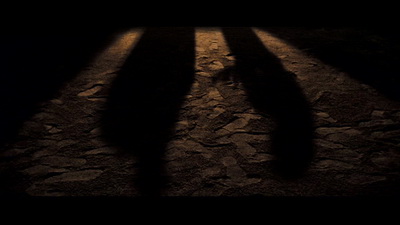 |
||
Shane Neill Chiaroscuro and perspective are the principle means in Western art by which the perception of multi-dimensional space is visually created in two dimensions. Though they might be understood to be two parts of the same perspectivizing practice, in fact chiaroscuro predates the ‘scientific perspective’ developed by Brunelleschi and Alberti in the early 15th century. (cf. Bell) And interestingly, with the modern development of photography, chiaroscuro is the means by which photography most idiomatically creates space. In On Photography, Susan Sontag explains: In expository scenes, lighting and perspective are often generalized or complicit with one another. Why is this so? At the beginning of any work, be it musical, literary, or cinematic, the work is in binary opposition to the audience. The work and the world it conveys is outside or ‘other’ to the audience. As the audience gradually assumes a suspension of disbelief, this binary opposition dissolves, ‘breaking the fourth wall,’ and creating the opportunity for the introduction of a secondary ‘other’ within the work. Though this secondary opposition can be abstract, such as a moral ambiguity, or an atmospheric or phenomenal dissonance, its presence creates a spatial and/or temporal duality. This is wherein the use of chiaroscuro and perspective become special effects; in conveying the spatial overlapping or in the simultaneity of such oppositions. In the scene between the queen and Theron, each character opposes the other on the moral/legal question of Leonides’ actions: the queen in favour, Theron opposed. The representation of their characters together in this scene presents the simultaneous spatialization of the dramatic opposition. Perspective and chiaroscuro are used to spatially define their moral position. The queen’s illuminous presence within the shadows is outside the space and light source of perspective that constructs the rest of the frame wherein the out-of-frame moon casts light slightly askew to the perspectival geometry and obscures Theron in shadow. As the scene progresses and her position is morally and visually compromised or equivocated with that of Theron, the frame shifts to cast them in the same centred perspective. Both figures are drenched in shadows against the distant light source that fades into the foreground. At the end of the scene the frame abstracts their figures, focusing on their shadows cast onto the ground. Their shadows are visually and morally upside down; the high angle of the perspective is subverted to the geometry of the light source casting the two figures. The geometry of the chiaroscuro renders a false sense of perspective—the lines of which if traced cast the characters beyond the geometrical vanishing point. Admittedly, this is a highly-overwrought reading of an effect which was most likely conceived through intuition, but it underscores the possibility of future intentional manipulations of the two spatializing methods. From a technical standpoint, given that the film is largely shot against a green screen, the emphasis of chiaroscuro over perspective is natural. Because the frames are often physically shallow, with grandiose extra-perspectival natural or Romantic back drops post-processed in, there is not enough physical space to create realistic perspective without Palladian theatrical tricks. Depth isexpressed through the tension between the angularity of distorted perspective coupled with skewed light sources. As space can be seen or experienced to be constructed, it takes on a fictive or imaginary nature. In the acknowledgement that it is not ‘real’ and in the exploitation of tension to create it, space is more easily imbued with narrative or special effect. Concluding with Deleuze: Bell, Janis Callen. "Chiaroscuro." Grove Art Online. Oxford Art Online. 31 Oct. 2011 Bell, Janis Callen. "Perspective." Grove Art Online. Oxford Art Online. 31 Oct. 2011 Sontag, Susan. On Photography. New York: Farrar, Straus and Giroux. 1977.
|
|||||
| 12. | 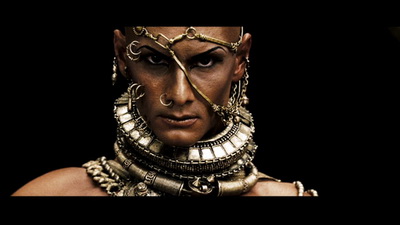 |
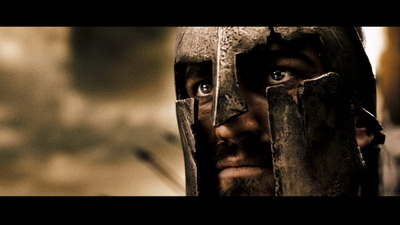 |
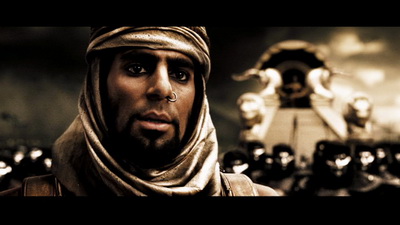 |
||
Michelle Greyling Face shots in the film "300" are portrayed with either the top of the head or both the top and bottom of the head cut off. The film "300" is captured in Panavision format with a very wide ratio of 2.40:1. The primary reason for manner facial shots are captured in "300" is the result or consequence of the aspect ratio which is said to be 2.35:1. This ratio however is noted to be rather the actual ratio of 2.39:1 which is labelled 2.40:1 by the American Society of cinematographers but is often wrongfully called 2.35:1 due to old habit. It is noted also that only the cinema films prior to 1970 actually used the 2.35: 1 aspect ratio.
|
|||||
| 13. | 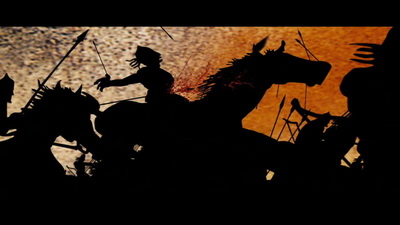 |
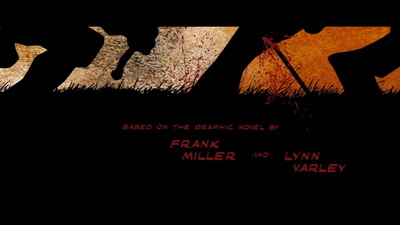 |
 |
||
Richard D'Allessandro The opening credits of a film, should the producers opt for the traditional opening credits versus the more recently made popular ending credits, occupy an important moment precluding the actual viewing of the film. This brief but captious moment signifies the beginning of the cinematic experience; where the audience rests their corporeal selves in the darkness and the mental link between screen and story is formed. Introducing the creators and artisans responsible for the production, first and foremost, is arguably an appropriate use of such a sensitive and precarious span of the audience’s attention. Accompanying the opening credits with some sort of backdrop has also been common practice since the advent of film and film screenings. Though, while the cinematic complexity of this backdrop has been known to vary a great deal, it has quite consistently been used as a clever introductory device. Whether this device is characterized by simple graphics or a series of abstractly shot scenes, the definite intent is to introduce the mood of the film. More aptly, this can be defined as the general effect of the film, cinematic method of storytelling, or the more subtle visual and even acoustic qualities of the experience to come. |
|||||
| 14. | 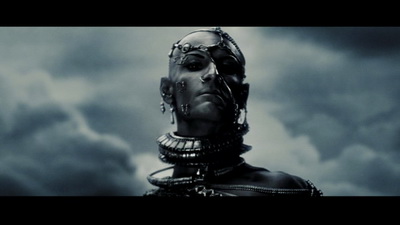 |
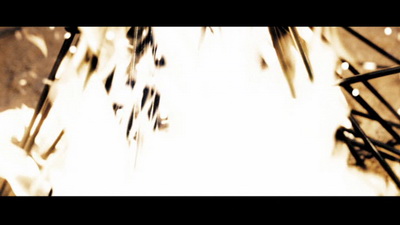 |
 |
||
Talayeh Hamidya
|
|||||
| 15. |  |
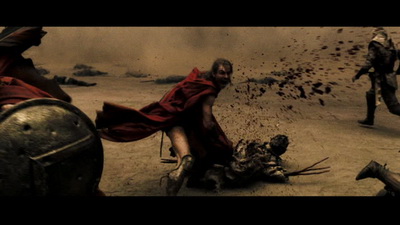 |
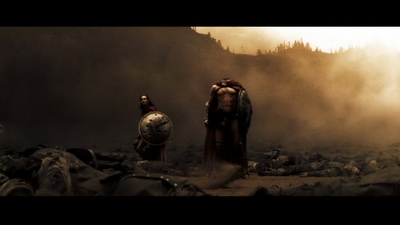 |
||
Maryam Abedini Rad Slow motion is ubiquitous in modern filmmaking. It is used by a diverse range of directors to achieve diverse effects. Slow motion is used widely in action films for dramatic effect or commonly used to show in detail some actions.It can also be used for artistic effect, to create a romantic or suspenseful aura or to stress a moment in time. In summary, Zack Snyder has used three different speeds for his movie: slow motion, regular motion and fast motion. The scenes that are important are shown in slow motion, the dialogues are in regular motion and unimportant or predictable scenes are in fast motion. This gives the audience a unique experience; he just sees important scenes and dramatic effects or details. http://en.wikipedia.org/wiki/Slow_motion |
|||||
| 16. | 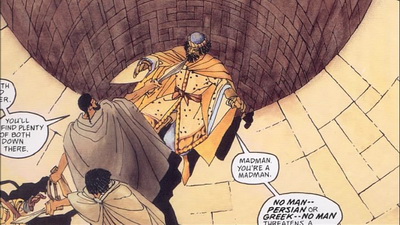 |
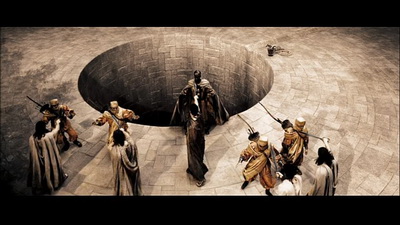 |
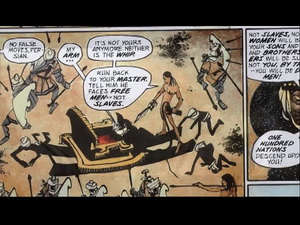 |
||
Jamie Usas 300, directed by Zack Snyder and adapted from Frank Miller’s graphic novel by the same title, successfully transforms a graphic work into a cinematic experience. The impact of 300’s highly visual style, however, is not the result of any one effect, but a carefully composed composite of varying subtle effects. Through the use of speed ramping, matte painting and forced perspective, Snyder has broken notable ground in the contemporary field of the comic-to-film adaptation genre. The film employs a ubiquitous use of speed ramping (shifting from fast to slow-motion) that functions to abstract moments in time into a nearly graphic cell stillness, which distances the viewer from the extreme violence of the film and effectively suggests a certain beauty and gracefulness to the act of war. As all of production was located within the confines of a sound stage, the in-camera depth of every shot was reduced to foreground and mid-ground, leaving nearly all background imagery to the hands of matte painting artists. This consistent flattening of each image acts as a subtle device to again distance the viewer from a sense of reality within the frame and maintain a graphic novel quality to each image. Synder’s subtle distortions of reality continue through the use of forced perspectives, achieved by employing the effects of matte painting to the foreground and mid-ground of the frame, reducing and exaggerating the depth, achieving a certain graphic quality to the image. Combining these visual effects, Snyder has done justice to the often disappointing adaptation of anime to live-action. If a shortcoming must be related as resulting from Snyder’s treatment of 300, it is no doubt in the simplistic use of dialogue throughout the film. While effective in the medium of graphic novels, the choppy dialogue of 300 does little to draw the viewer into the film and sadly acts more to distract than suspend disbelief.
|
|||||
updated 22-Dec-2011 2:28 PM